Mastbaum Theatre
2001 Market Streat
Philadelphia, PA
Note: Not extant. Not playable. (in this location)
Images
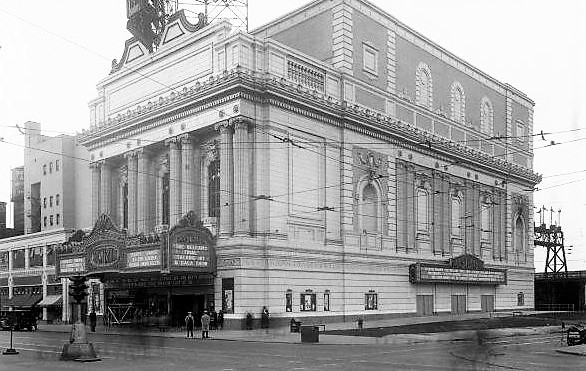 1928 - Building exterior (Photograph by cinematreasures.org, submitted by Jeff Scofield/Jeff Scofield)
1928 - Building exterior (Photograph by cinematreasures.org, submitted by Jeff Scofield/Jeff Scofield)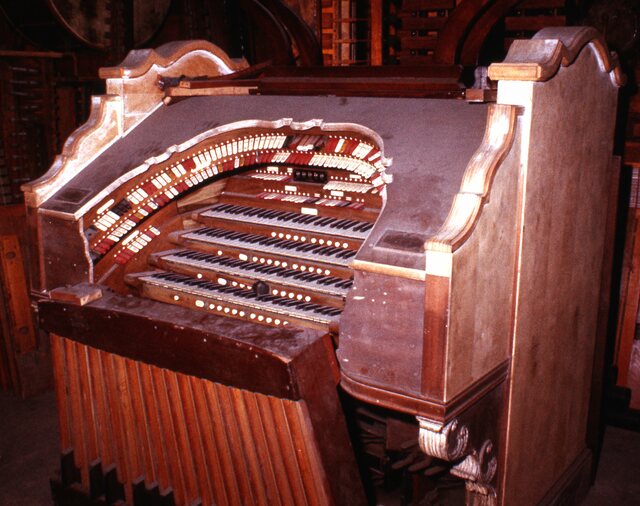 1980 - Console while in storage in Tennessee (Photograph by cinematreasures.org, submitted by Jeff Scofield/Jeff Scofield)
1980 - Console while in storage in Tennessee (Photograph by cinematreasures.org, submitted by Jeff Scofield/Jeff Scofield)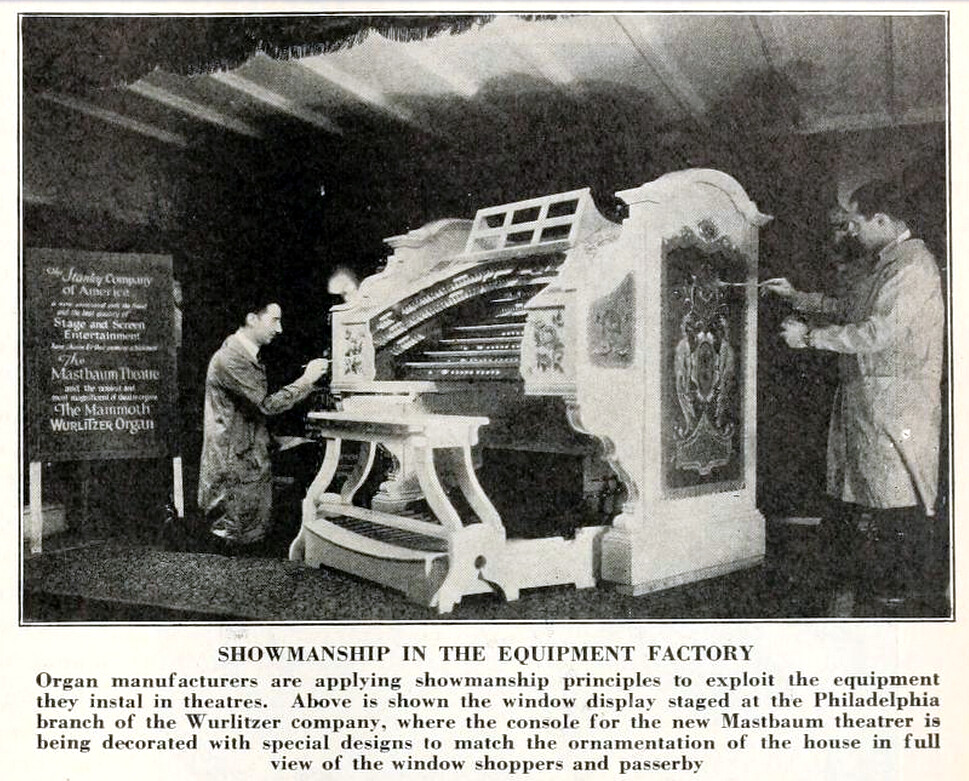 1928 - Article about finishing the console (Photograph from an archival source: cinematreasures.org, submitted by Jeff Scofield/Jeff Scofield)
1928 - Article about finishing the console (Photograph from an archival source: cinematreasures.org, submitted by Jeff Scofield/Jeff Scofield)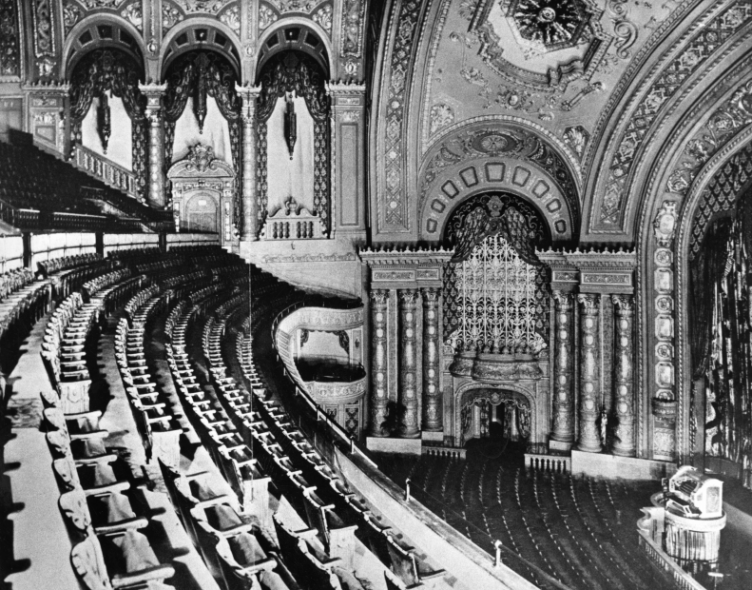 1928 - Theatre interior and console from balcony (Photograph by pinterest.com, submitted by Jeff Scofield/Jeff Scofield)
1928 - Theatre interior and console from balcony (Photograph by pinterest.com, submitted by Jeff Scofield/Jeff Scofield)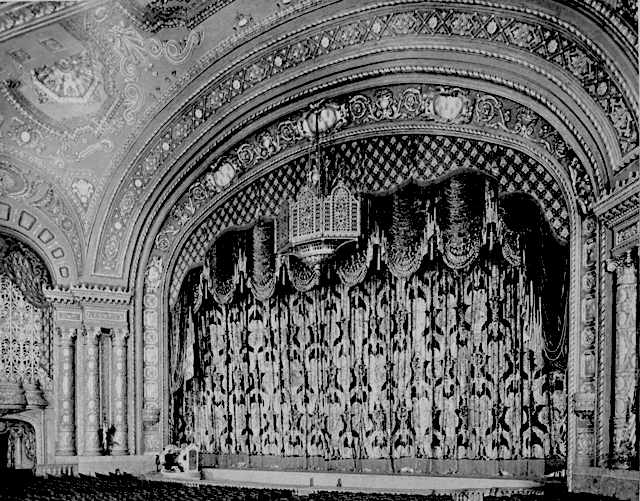 1929 - Proscenium and console (Photograph from an archival source: Jim Lewis, submitted by Jim Lewis/Jim Lewis)
1929 - Proscenium and console (Photograph from an archival source: Jim Lewis, submitted by Jim Lewis/Jim Lewis)
Consoles
Main
Notes
2013-11-07 - This entry describes an original installation of a new pipe organ.
Identified by William Dunklin, using information found in David Junchen <em>The Wurlitzer Pipe Organ, an Illustrated History</em> p. 692.
-- Wurlitzer's 2000th organ was a custom designed instrument on high pressure, 15" and 25 inches in order to fill the vast auditorium of almost 5000 seats. The magnificent Mastbaum Theatre proved to be a white elephant: never successful and reportedly closed more often than open. The organ was removed before the building was torn down in 1958. Though removed intact, opus 2000 was ultimately broken up for parts. -Database Manager
2016-07-23 - Wurlitzer "Style Sp 4m"<br>
Factory date: November 30, 1928 -Database Manager
2023-01-23 - From cinematreasures.org: Located at the northwest corner of N. 20th Street and Market Street. The Mastbaum Theatre was the largest and most lavish movie palace ever in Philadelphia. With 4,717 seats, it was the 8th largest, and one of the grandest in the United States. Its grandeur impressed Hollywood studios, and helped put Philadelphia on the national movie map for releases. It was also a ‘White Elephant’, closed more often than it was open. It was too huge and expensive to operate, and a bit too far away from the subway.
Jules Mastbaum, president of the Stanley Company, planned the Jules Theatre, but he died. Warner Bros. took over the Stanley Company and with Philadelphia theatre architects Hoffman-Henon Co., built the Mastbaum Memorial Theatre in his memory.
Costing five and a half million dollars to build, the Mastbaum Theatre’s interior was incredibly lavish, with marble, murals, gold leaf, leaded glass, tapestries, statues, paintings, and Czechoslovakian and other crystal chandeliers. A Carriage Lobby led to the Grand Lobby, which had a Fountain Lobby. There was a Grand Foyer, a main lounge downstairs, and elevators to all 8 levels. The auditorium had three balconies, a 4-manual Wurlitzer organ which was opened by organist Stuart Barrie, and both the largest chandelier and the largest fire curtain in Philadelphia. A detailed description by Irvin R. Glazer appeared in Marquee Vol 7, No 1(1975) of the Theatre Historical Society, republished in Vol 37, No 2(2005).
The February 28, 1929 gala opening presented stage entertainment, the world premiere of the Warner Bros. movie “Sonny Boy” starring Davey Lee, a 75 piece pit orchestra, a choral ensemble of 50 and a corps de ballet of 32. At times, the Mastbuam Theatre packed them in, but overall lost money because it could not bring in large enough audiences compared to the size and costs of the place. Opera was the policy in 1933. In 1934, Samuel L. Rothafel, “Roxy” was brought in to attract audiences, but within 2 months the theatre closed.
The Mastbaum Theatre seldom opened again during the Great Depression, until World War Two when military expenditures saw many people employed in Philadelphia. In September, 1942, the movie “Tales of Manhattan” reopened the Mastbaum Theatre. The balconies were usually closed, but movies were shown with Irving Berlin’s “This is the Army” having its premiere here and a sold out run, in 1942. Occasional stage shows featured Eddie Fisher, Dean Martin and Jerry Lewis, and Judy Garland. Among popular movies shown were “Casablanca” in 1943, “Going My Way” in 1944, “Quo Vadis” (which had a ten-week run) and “African Queen” in 1952, and Hitchcock’s “I Confess” in 1953. With John Garfield appearing, “Pride of the Marines” had its world premiere in Philadelphia, in August, 1945, with first a private screening in the Bellevue Stratford Hotel ballroom, and then opened to the public at the Mastbaum Theatre. “The Bells of St. Mary” was such a popular film in 1946 that it became ‘standing room only’. In the summer of 1950, star Wanda Hendrix appeared at the Mastbaum Theatre to promote her film “The Admiral Was a Lady”. “Tripoli” had its world premiere here (concurrent with a cinema in both Tokyo and Seoul) on October 13, 1950. On May 23, 1951, star Eveyln Keyes appeared on the Mastbaum Theatre stage at a world premiere of the film noir “The Prowler”. -Jeff Scofield
Other Links
Regrettably, it is not possible to display the information about the sponsor of this pipeorgandatabase entry or if there is a sponsor. Please see About Sponsors on Pipe Organ Database.




